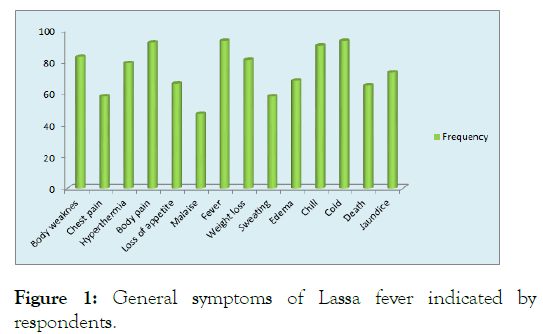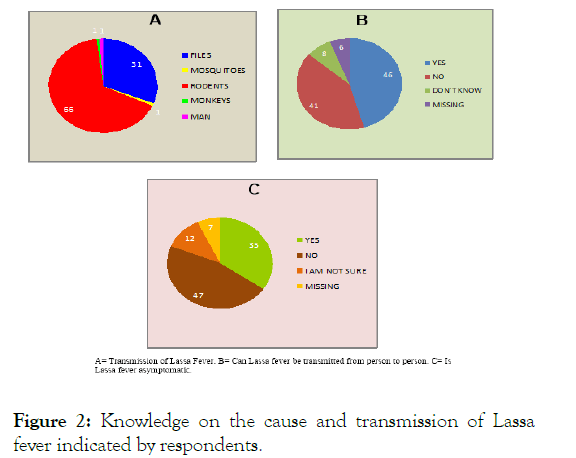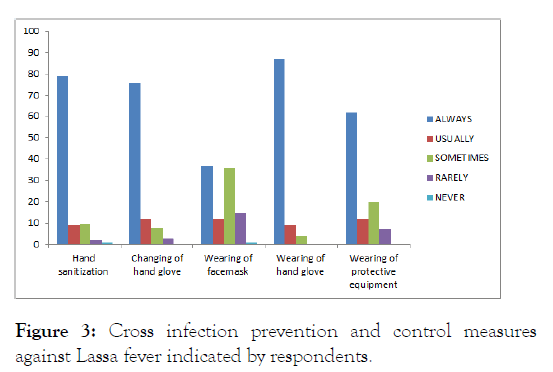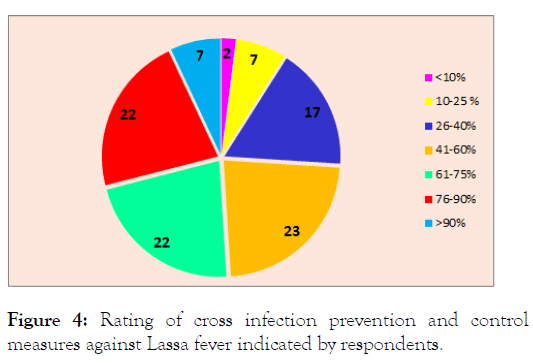PMC/PubMed Indexed Articles
Indexed In
- Open J Gate
- Genamics JournalSeek
- Academic Keys
- JournalTOCs
- ResearchBible
- Ulrich's Periodicals Directory
- Access to Global Online Research in Agriculture (AGORA)
- Electronic Journals Library
- RefSeek
- Hamdard University
- EBSCO A-Z
- OCLC- WorldCat
- SWB online catalog
- Virtual Library of Biology (vifabio)
- Publons
- MIAR
- Geneva Foundation for Medical Education and Research
- Euro Pub
- Google Scholar
Useful Links
Share This Page
Journal Flyer

Open Access Journals
- Agri and Aquaculture
- Biochemistry
- Bioinformatics & Systems Biology
- Business & Management
- Chemistry
- Clinical Sciences
- Engineering
- Food & Nutrition
- General Science
- Genetics & Molecular Biology
- Immunology & Microbiology
- Medical Sciences
- Neuroscience & Psychology
- Nursing & Health Care
- Pharmaceutical Sciences
Research Article - (2021) Volume 12, Issue 3
Level of Knowledge among Doctors and Nurses against Lassa Fever and the Control Mechanisms in FMC, Umuahia
Onyenwe Chinyere Patience1, Ezugworie Flora Nnenna2*, Ajaegbu Eze Elijah2, Ogbonna Chineme Florence3, Iloabuchi Lucy Chineye2, Dieke Adaobi Janefrances2, Onah Gloria3, Nwaobodo Angel Chineye2 and Ugochukwu Jane Ijeoma42Department of Applied Sciences, Federal College of Dental Technology and Therapy Enugu, Enugu, Nigeria
3Department of Statistics, Abia State Polytechnic, Aba, Nigeria
4Department of Pharmaceutical Microbiology and Biotechnology, Enugu State University of Sciences and Technology, Enugu, Nigeria
Received: 19-Mar-2021 Published: 08-Apr-2021, DOI: 10.35248/2155-9597.21.12.397
Abstract
Background: Lassa fever is a zoonotic viral infection caused by rodents and is presently endemic in some part of Nigeria. The cross infection prevention and control measures practiced by doctors and nurses in Federal Medical Centre (FMC) Umuahia in Abia state was assessed along with the readiness of the health workers on the current Lassa fever outbreak.
Methods: Well-structured questionnaire was used to collect data from the respondents. Data on the level of knowledge of respondents and their risk perception on the outbreak were collected and the proportion of risk perception was estimated.
Results: One hundred and one respondents were recorded, 97 (96.0%) were aware of the current outbreak, 46 (45.5%) are aware of person to person transmission while 41 (40.6%) are not. Risk perception among doctors and nurses is up to 90.1%, 5.9% are not but 4% are not sure whether they are at risk. Up to 89.1% of the respondents are educated on the precaution measures while others are ignorant of them. Always sanitizing of hand after contact with patients recorded 79 (78.2%), 76 (75.2%) always change their hand gloves between patients, 37 (36.6%) always use facemask while attending to patients, 87 (86.1%) always wear their hand gloves while handling patient’s body fluid and materials, 62 (61.4%) always wear their personal protective equipment while caring for patients. The rate of readiness of doctors and nurses in FMC Umuahia Abia state was rated over 100% and only 43 (42.6%) are ready for the outbreak, others are not prepared.
Conclusion: From all indication, there is a gap in the flow of knowledge on prevention and cross infection control measures among doctors and nurses in FMC, Umuahia. Refresher training should be conducted and adequate preventive equipment made available.
Keywords
Lassa fever; Prevention; Knowledge; Cross control measures; Body fluid; Umuahia
Introduction
Lassa fever is an acute viral zoonotic haemorrhagic illness caused by Lassa virus from the family of Arenaviridae [1]. Lassa fever can be symptomatic and asymptomatic. In the symptomatic case, such symptom like muscle ache, vomiting, abdominal and chest pain are experienced but no symptoms are shown in asymptomatic cases. Lassa fever is endemic in Nigeria and other West Africa counties like Mali, Senegal, Guinea, Liberia, Sierra Leone, Ghana and Ivory Coast [2,3]. The virus can be primarily contracted through contact with the excreta of infected rodent of genus Mastomys (known as multimammate rat) or the inhalation of the aerosolized virus from the urine or faeces of the infected rodent. Contact with the body fluid of an infected person as stated by WHO and CDCP, can also lead to person to person transmission [3-5]. Clinical diagnosis of Lassa fever is usually difficult due to the similarities in the symptom with the symptoms of viral and bacterial infections and the asymptomatic nature of the viral infection. The early symptoms are always mistaken for malaria and typhoid fever which leads to the rapid transmission of the virus among health workers. Other symptom used to diagnose Lassa fever include; sore throat, bleeding from orifices, resistant to both antimalarial and antibiotic drugs, vomiting, abdominal pains, damage of multiple organ and loss of sensor neural which occur at the later stage of the infection period [1]. Lassa fever is presently endemic in Nigeria with 26 states affected. The highest cases recorded are from Edo (167 cases), Ondo (156 cases) and Ebonyi (30 cases), that is 75% of the total number while the remaining 25% is distributed among the other 23 states as of February 2020 [6]. According to NCDC, people of all ages are susceptible to the virus including health workers thus advised the general public to enhance the personal and environmental hygiene by storing food in a ratproof containers, reporting early symptoms and reducing human and rodent interaction [7]. The Outbreak of Lassa fever viral is usually rampart during dry season more than rainy season [8]. Reports from Iyere, portrayed Lassa fever a nosocomial viral infection and as such has high tendency for cross infection [9]. The cross infection occur mostly between health workers (who neglect to use their hand sanitizers, change their gloves after handling a patients) to patients or patients to relatives. Potential source of cross infection include; drugs, foodstuff, contaminated surfaces and intravenous solutions [9,10]. The major challenge about this viral outbreak is lack of knowledge and practice of preventive measure against Lassa fever virus. Most of the health workers who are supposed to educate people on the importance of practicing preventive measures against this virus are also ignorant of the viral outbreak while others overlook the preventive measures in the course of handling patients. The aim of this study is to analyse the level of knowledge among doctors and nurses and their control mechanism against Lassa fever virus in Federal Medical Centre (FMC) Umuahia, Abia state which is one of the states affected with the viral outbreak.
Materials and Methods
Research design
A descriptive survey research was carried out among participants by collecting and analysing data from them in order to understand how efficient they are in implementing the preventive/precautionary measures against Lassa fever virus.
Study population and sampling technique
The study was conducted for all health workers in Federal Medical Centre, Umuahia, Abia State. The sample size for the experiment was 101 male and female from Federal Medical Centre Umuahia. Selective (purposive or Judgement) sampling method was used and all participants were health workers in Federal Medical Centre Umuahia.
Instrument of data collection
A well-structured questionnaire titled “Questionnaire on level of Knowledge among Health Workers against Lassa fever and its control mechanisms in FMC, Umuahia” was used to collect data for the survey. The questionnaire is made up of 6 sections with close ended questions. Section A consists of demographic data such as age, gender, profession and years of practice. Section B enquired on the knowledge of the participants about the recent Lassa fever outbreak, the cause, transmission of Lassa fever and whether it is symptomatic or asymptomatic. In section C, question about the symptoms of Lassa fever is asked; the general, gastrointestinal, Neurological, Respiratory, haematological and dermatological symptoms. Section D was about the preventive measures against Lassa fever known to respondents. Section E dealt with the level of knowledge the respondents have about cross infection control practices and precautions. The last section (F) handles the analyses section E and asks question on the readiness of the respondents on the outbreak of Lassa fever.
Method of data collection
The questionnaire was distributed to the health workers by the researcher with the help of a research assistant who was trained on how to interpret and record the responses from the respondents. Due to the shift in duty time for health worker, the distribution and collection of the questionnaire lasted for 4 weeks.
Method of data analysis
The data collected was tallied and coded at the end of the collection exercise and SPSS version 23 was used to analyse the coded data. Descriptive statistics of mean and frequency distribution tables were used in answering the research questions.
Results
Table below shows the demographic data of the respondents such as age, gender, profession and years of practice (Table 1).
| Data | Frequency | Percentage (%) |
|---|---|---|
| Age | ||
| 10-20 | 17 | 16.8 |
| 21-30 | 53 | 52.5 |
| 31-40 | 20 | 19.8 |
| 41-50 | 7 | 6.9 |
| 51-60 | 3 | 3 |
| Gender | ||
| Male | 15 | 14.9 |
| Female | 85 | 84.2 |
| Profession | ||
| Nurse | 88 | 87.1 |
| Medical doctor | 12 | 11.9 |
| Years of practice | ||
| 1-10 | 75 | 74.3 |
| 11-20 | 13 | 12.9 |
| 20-30 | 4 | 4 |
| >30 | 1 | 1 |
Table 1: Demographic data of participants.
The highest percentage in age was observed on the age group of 21-30 years with 52.5%. 84.2% of the respondents were female and 14.9% were male.Respondents were only Medical doctors (11.9%) and Nurses (88.1%) with the highest percentage (74.3%) of years of practice within the range of 1-10 years. The general knowledge of respondents about Lassa fever was recorded in section B. About 96% of the respondents were aware of the resent Lassa fever outbreak. 4% of the respondents believe that bacteria is the cause of Lassa fever, 2% said fungi while 92.1% indicated virus as the cause of Lassa fever. Figure below showed the response of participant on the transmission of Lassa fever (Figure 1).

Figure 1: General symptoms of Lassa fever indicated by respondents.
The frequency of respondent who agreed that Lassa fever can be transmitted from person to person is 46 while 41 disagreed. 8 participants have no idea while 6 remained silent. 34.7% of the respondent agreed that a person infected with Lassa fever virus can be asymptomatic while 46.5% disagreed. 11.9% have no idea while 6.9% remained silent to the matter. The respondents have advanced knowledge on the general symptoms of Lassa fever as shown (Figure 2).

Figure 2: Knowledge on the cause and transmission of Lassa fever indicated by respondents.
The highest percentage was observed in fever and cold with a frequency of 93, followed closely by body pains and chill with frequency of 92 and 90 respectively. In Gastrointestinal symptoms, the frequencies for hematemesis, oral sore, nausea and abdominal discomfort were below 50% (22, 43, 12 and 15 respectively). Other gastrointestinal symptoms include; vomiting 81.2%, Diarrhoea 52.5%, sore throat 60.4%, epigastric pain 73.3%, gastrointestinal bleeding 76.2%, hematochezia 71.3%, abdominal pain 85.1%, Inability to swallow 88.1%, dehydration 82.2% and dysentery 80.2%. Other symptoms like Neurological, Respiratory, Haematological and Dermatological symptoms were displayed (Table 2).
| Symptoms | Frequency | Percentage (%) |
|---|---|---|
| Neurological symptoms | ||
| Nervousness | 68 | 67.3 |
| Loss of consciousness | 56 | 55.4 |
| Confusion | 55 | 54.4 |
| Headache | 28 | 27.7 |
| Convulsion | 72 | 71.3 |
| Dizziness | 98 | 97 |
| Lethargy | 44 | 43.6 |
| Drowsiness | 73 | 72.5 |
| Migraine headache | 82 | 81.2 |
| Respiratory symptom | ||
| Obstruction of airways | 98 | 97.5 |
| Dyspnoea | 73 | 72.3 |
| Sneezing | 51 | 50.5 |
| Cough | 66 | 65.3 |
| Respiratory discomfort | 31 | 30.7 |
| Rhinorrhoea | 39 | 38.6 |
| Haematological symptoms | ||
| Bleeding from the eye | 48 | 47.5 |
| Bleeding from the orifice | 50 | 49 |
| Bleeding from the ear | 25 | 24.8 |
| Blurred vision | 84 | 83.2 |
| Epistasis | 52 | 51.5 |
| Haematuria | 71 | 70.3 |
| Ophthalmologic | 77 | 76.2 |
| Yellowness of eye | 78 | 77.2 |
| Anaemia | 42 | 41.6 |
| Haemorrhage | 98 | 97 |
| Bleeding from the mouth | 57 | 56.4 |
| Conjunctivitis | 84 | 83.2 |
| Dermatological symptoms | ||
| Blisters | 55 | 54.5 |
| Cardiovascular | 48 | 47.5 |
| Arthralgia | 58 | 57.4 |
Table 2: Other symptoms of Lassa fever.
In section E, 90.1% of the respondents indicated that they are at risk, 5.9% said they were not at risk while 4% have no idea. Up to 89.1% of the respondents are educated on the universal precautionary measures against Lassa fever virus, 4% accepted that they are ignorant while 5% have no idea what they were. From figure below, some of the preventive measures practiced by the respondents were evaluated (Figure 3).

Figure 3: Cross infection prevention and control measures against Lassa fever indicated by respondents.
About 31.7% of the respondents wear their personal protective equipment outside the surrounding of their duty post while 68.3% don’t. Only 55.4% of the respondents have a special wardrobe for their hospital wears while 43.6 share wardrobes or do not have at all. Borrowing of hospital wears are practiced by 13.9% of the respondents while 86.1% of the respondents do not share hospital wears with their colleagues. Figure below shows the rate of respondents cross infection prevention and control practice against the present Lassa fever virus outbreak, when asked to rate themselves (Figure 4). The highest frequency 23 was recorded with 41%-60%, followed by 61%-75% and 76%-90% with the frequency of 22 each. Only 7 respondents indicated >90% while <40% was recorded for 26 respondents.

Figure 4: Rating of cross infection prevention and control measures against Lassa fever indicated by respondents.
Discussion
From this study, almost all the respondents are aware of the current Lassa fever outbreak, and that it is a viral disease. Their level of knowledge on the mode of transmission of Lassa fever virus was also above average as more than half of the respondents indicated rodents as the main vectors of transmission while the rest pointed toward files as the vectors for the virus. The high level of knowledge is in line with the report by Asuke, unlike the fair knowledge reported by Ijarotimi [11,12]. Respondents are also well grounded on the different symptoms of Lassa fever virus which include; the general symptom, gastrointestinal, neurological, respiratory, haematological and dermatological symptoms of Lassa fever virus. All these knowledge will be of no use if the respondents have no knowledge on the preventive measures against Lassa fever. Out of the 59 preventive measures against Lassa fever in the state, respondents indicated 35 of them as the preventive measure carried out by the state against Lassa fever virus. The level of risk perception by respondents is very high due to the profession as they are always at the fore front during outbreaks of this viral infection. Almost all the respondents have risk perception about the current outbreak and indicated that they have good knowledge about the universal precaution measure against Lassa fever infection. There is a big different between having the knowledge and practicing the cross infection control measures. Just like the report by Asuke, stating that the morbidity and mortality of Lassa fever can be reduced by the positive attitude of health worker towards cross infection prevention and control practices [12]. From this study, almost all the respondents practice the cross infection prevention and control measures although the few that are reluctant to these practices can be a big problem to others, thus enhancing cross infection from one patient to another or to their colleagues due to their ignorance or due to negligence. From the evaluation of readiness towards the current Lassa fever outbreak, not up to half of the doctors and nurses are ready for the current Lassa fever outbreak. Some of them (28.7%) are not sure whether they are ready or not while some (28.7%) are not ready. The readiness was based on the cross prevention and control practices practised by the doctors and nurses. Due to this fact, effects should be made to implement the cross preventive control measures and more health worker should be trained so that in subsequent outbreak, all health personnel’s may be well equipped with the necessary knowledge.
Conclusion
From this survey, it was observed that very few doctors and nurses in Federal Medical Centre Umuahia are not aware of the prevention and control measures against Lassa fever virus hence they are at constant risk. Refresher course on the prevention and cross infection control measures should be organised for doctors, nurses and other health worker while the government and management ensure that protective equipment and hospital wears are made available, to reduce the risk perception and ensure proper protection of the health worker who are always at the front line of the outbreak.
REFERENCES
- Abdulkadir S, Mohammed AS. Assessment of knowledge of Lassa fever among residents in north-eastern Nigeria. Int J Health Sci Res. 2019;9(2):197-202.
- Adesoji JO, Yinusa MA, Adijat JA, Abdulateef R, Kehinde K, Akindele I. Knowledge beliefs and sources of information on Lassa fever among residents of a community in ilorin Nigeria. Rom J Sociological Studies. 2016;11(2):153-166.
- Usuwa IS, Akpa CO, Umeokonkwo CD, Umoke M, Oguanuo CS, Olorukooba A et al. Knowledge and risk perception towards Lassa fever infection among residents of affected communities in Ebonyi state, Nigeria: implications for risk communication. BMC Public Health. 2020;20(1):217.
- Lassa fever. World Health Organisation. 2017.
- Lassa fever. Centers for Disease Control and Prevention. 2019.
- Lassa fever. World Health Organisation. 2020.
- Lassa fever. Nigeria Center for Disease Control. 2019.
- Ossai EN, Onwe OE, Okeagu NP, Ugwuoru AL, Eze TK, Nwede AS. Knowledge and preventive practices against Lassa fever among heads of households in Abakaliki metropolis, southeast Nigeria: A cross-sectional study. Proceedings of Singapore Healthcare. 2020;29(2):73-80.
- Faith I, Harrison E, Alphonsus OA, Ekundare FO, Eloho RU, Charles OO, et al. Knowledge, Attitude and Infection Prevention and Control Practices Regarding Lassa fever among Healthcare Workers in Edo State, Nigeria. Int J Prev Med Treatment. 2019;8(1):21-27.
- Ijarotimi IT, Ilesanmi OS, Aderinwale A, Abiodun-Adewusi O, Okon IM. Knowledge of Lassa fever and use of infection prevention and control facilities among health care workers during Lassa fever outbreak in Ondo State, Nigeria. Pan Afr Med J. 2018;30(1):56.
- Joseph NM, Sistla S, Dutta TK, Badhe AS, Rasitha D, Parija SC. Role of intensive care unit environment and health-care workers in transmission of ventilator associated pneumonia. J Infect Dev Ctries. 2010;4(5):282-291.
- Asuke S, Agubamah E, Ibrahim MS, Ovosi JO. Knowledge, attitude, and practice toward Lassa fever prevention and control among health care providers in Sabon Gari local government area, Kaduna state, Nigeria. J Med Trop. 2020;22(1):1-7.
Citation: Patience OC, Nnenna EF, Elijah AE, Florence OC, Chineye IL, Janefrances DA, et al. (2021) Level of Knowledge among Doctors and Nurses against Lassa Fever and the Control Mechanisms in FMC, Umuahia. J Bacteriol Parasitol. 12: 397.
Copyright: © 2021 Patience OC , et al. This is an open-access article distributed under the terms of the Creative Commons Attribution License, which permits unrestricted use, distribution, and reproduction in any medium, provided the original author and source are credited.


